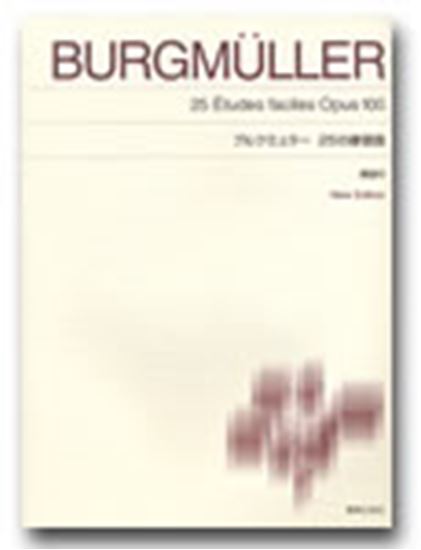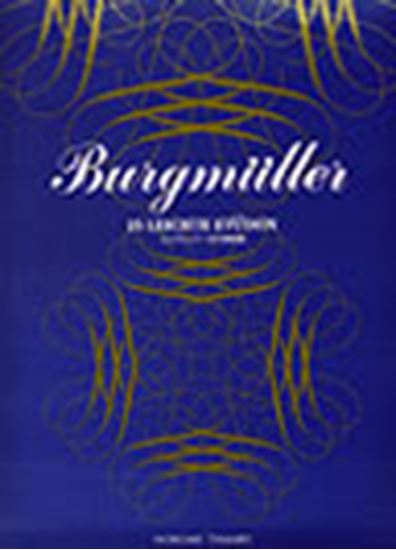Burgmüller, Johann Friedrich Franz : 25 Etudes faciles et progressives, conposées et doigtées expressément pour l'étendue des petites mains L'arabesque Op.100-2
Work Overview
Genre:etude
Total Playing Time:1 min 00 sec
Copyright:Public Domain
Additional Notes:表記ゆれの例: からくさもよう
Commentary (4)
Author : Ooi, Kazurou
Last Updated: October 17, 2022
[Open]
Author : Ooi, Kazurou
For this piece, one must first begin by ensuring the evenness and consistency of 16th notes. If there are five notes, such as A, H, C, D, E, it is unavoidable to use fingerings like 1-2-3-4-5 or 5-4-3-2-1. Learners should first focus solely on fingers 3-4-5 to gain freedom, practicing diligently until the notes are perfectly even, thereby building muscle strength. This is where the process begins.
Another point is that even in passages involving only fingers 1-2-3, the evenness of notes tends to break down when black keys are introduced. At such times, is the shape of your first joint properly maintained? Learners whose finger shape is compromised should take this opportunity to correct it.
Furthermore, I will explain three crucial points for performing this piece.
1. Possessing Directionality
Consider the directionality of each phrase—where it ends and where it leads—and apply dynamic control accordingly.
2. Avoiding Flat Dynamics
Strive to achieve the widest possible dynamic range. For instance, in measure 6, which is the loudest point, try playing forte with the most power in your right hand's 5th finger.
3. Maintaining a Consistent Tempo
In this piece, be careful not to let the music rush forward as the dynamics increase. Never rush; play the left-hand chords consistently.
For other techniques, please refer to this video.
Author : Imazeki, Shiori
Last Updated: March 1, 2021
[Open]
Author : Imazeki, Shiori
2/4 time, A minor. Ternary form. An arabesque refers to an Arabic-style ornamental pattern, typically represented by geometric figures or scrollwork.
Section A is characterized by the left hand's staccato chords accompanying the short, stepwise ascending melody in the right hand. Conversely, in Section B, a long-breathed melody emerges in the right hand, while the left hand plays a fluctuating figuration of sixteenth notes.
Author : Sato, Takashi
Last Updated: January 26, 2022
[Open]
Author : Sato, Takashi
“Arabesque” refers to a geometric pattern used in art and architectural designs in Islamic cultures, resembling a “scroll pattern.” Schumann was the first to use the term “Arabesque” as a title for a piano piece, and Debussy’s Two Arabesques are also well-known.
While the intertwining arpeggio-like figures in both hands are often likened to “arabesque patterns,” Burgmüller’s “Arabesque” differs, possessing a brisk, march-like character. The author, returning to the original meaning of “arabesque” as “Arabic style,” identifies elements of Turkish music within it (refer to Burgmüller’s Rondo alla Turca, Op. 68-3); however, there is also a theory that the title is derived from the ballet term “arabesque” (one of the fundamental poses). The ability to expand one’s imagination from the multifaceted nature of the title is also one of the excellent aspects of this collection.
Performance Points (Original ♩ =152)
Let’s focus on differentiating between the various figures and articulations. Note the difference in expression between the undulating figure in measure 3 and the ascending figure in measure 4. In the first bracket of measure 10, a surprising sf is placed on the second beat, while the second bracket features a slurred octave leap. This changes how the first beat is played. Furthermore, you will notice that even within this short piece, various expressions are contained, such as the changes in articulation in measures 8 and 24. In measures 17 and 18, carefully check the positions of the black keys for both hands. Maintain a consistent tempo for the left hand’s repeated notes, and play the final two measures, which contain many leaps, also in tempo.
(From To-on Edition “Burgmüller 25 Etudes” (NS70))
Author : Iida, Arisa
Last Updated: March 15, 2018
[Open]
Author : Iida, Arisa
Musical example provided by: Ongaku no Tomo Sha
PTNA & Partner Channel Videos(32items) View More
Sheet MusicView More
Scores List (37)

(株)東音企画(バスティン)

(株)東音企画(バスティン)

(株)東音企画(バスティン)

(株)東音企画(バスティン)

(株)全音楽譜出版社

(株)全音楽譜出版社

(株)シンコーミュージックエンタテイメント

(株)全音楽譜出版社

(株)全音楽譜出版社

(株)ドレミ楽譜出版社

(株)音楽之友社

KMP(ケイ・エム・ピー) ケイエムピー

(株)ドレミ楽譜出版社

ハンナ(ショパン)

(株)ヤマハミュージックエンタテインメントホールディングス

デプロMP

(株)ドレミ楽譜出版社

(株)全音楽譜出版社

(株)ドレミ楽譜出版社

カワイ出版

カワイ出版

デプロMP

(株)ヤマハミュージックエンタテインメントホールディングス

デプロMP

(株)ドレミ楽譜出版社

(株)音楽之友社

(株)共同音楽出版社

(株)エー・ティ・エヌ

(株)全音楽譜出版社

(株)全音楽譜出版社

(株)音楽之友社

(株)ヤマハミュージックエンタテインメントホールディングス

(株)ヤマハミュージックエンタテインメントホールディングス

(株)ヤマハミュージックエンタテインメントホールディングス

Neil A. Kjos Music Company



















